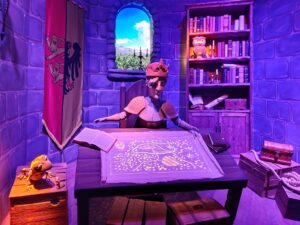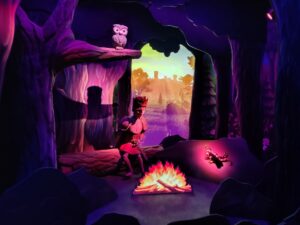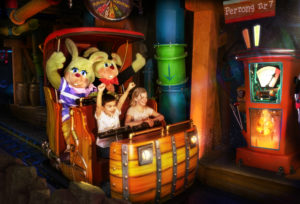Many theme parks are searching for ways to create experiences that require more involvement from their guests. One of the companies specializing in such interactive experiences is Alterface from Belgium. They have built many interactive attractions over the years, such as the very first interactive theatres in the world. The ride premiered as Desperado City in Bobbejaanland (Belgium) and was shortly followed by Ciné Desperados 3D in Fraispertuis City (France). We spoke with Laurence Beckers (Creative Director) and Benjamin Walravens (Show Producer) of Alterface about the development of Desperados and other interactive theaters.

Name: Laurence Beckers and Benjamin Walravens
Company: Alterface (Wavre – Belgium)
Since:
Laurence: 2002
Benjamin: 2008
Favorite (semi-) dark ride:
Laurence: “Do you consider Hagrid’s Magical Creatures Motorbike Adventure a dark ride?” (We don’t) “Then it’s Amazing Adventures of Spider-Man at Universal. Everything is fitting so well.”
Benjamin: “For me I would say, Indiana Jones Adventure, because of the motion vehicles. The ride system is just amazing.”
Favorite show ride:
Laurence: “The one in Pandora, Avatar: Flight of Passage.”
Benjamin: “Since we do so many show rides ourselves, I prefer to stay neutral.”

Alterface started as a company in 2001, but has a very different origin from most ride manufacturers. “There was a research project at the University of Louvain-La-Neuve. The idea was to show the people on the screen, like a magical mirror, and let them interact with the décor the virtual story that was displayed on the screen. It was possible to interact with the movements of hands and body,” explains Laurence. The project was a success and Alterface was created as a spin-off company from the university. The newly formed company focused on creating technology for new interactive experiences with audiovisual media.
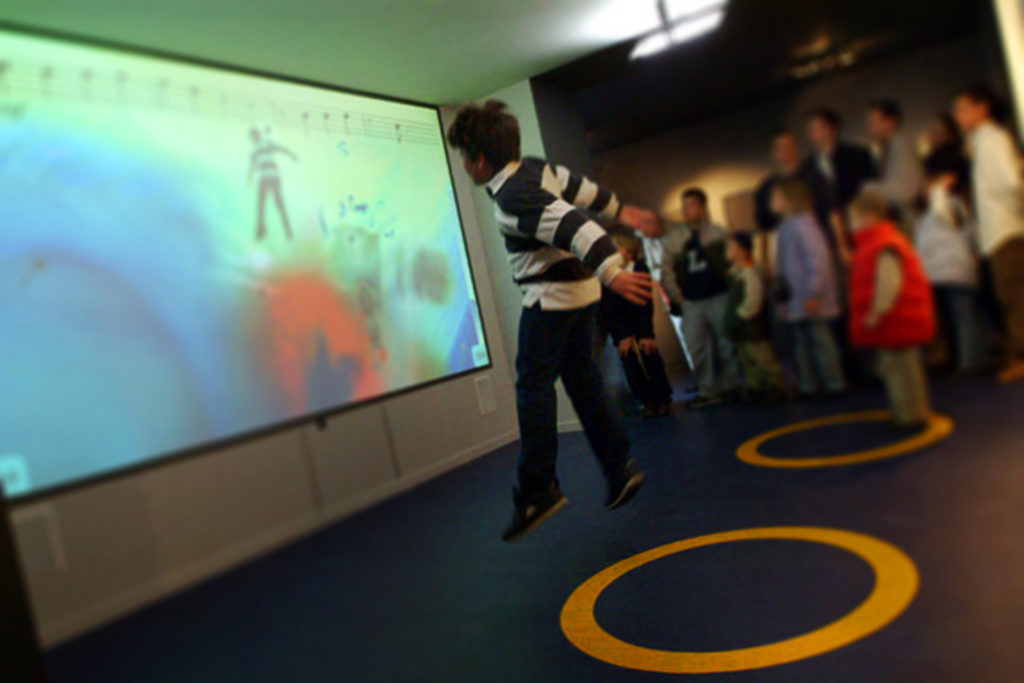
One of their early projects was for a museum, the Royal Belgian Institute of Natural Sciences, and contained a screen with a Dinosaur that could be controlled by movement. “It was like Kinect before Kinect,” says Benjamin, referring to the game system from Microsoft. “It was really innovative, but also unnatural for people to interact with their body,” adds Laurence. “Now, people understand how Kinect works, so if you put it in a museum or theme park, people will understand it, even little children. But 20 years ago, it was not so easy to make it understandable for the people and have them interact with it. That was challenging.” That challenge is always there when the company designs a new way of interaction, tells Benjamin: “it’s really difficult to invent new ways of interactivity that people can learn in a short period of time. The experience in a dark ride or theme park is usually very short, so it has to be very straightforward or obvious in order for people to understand.”
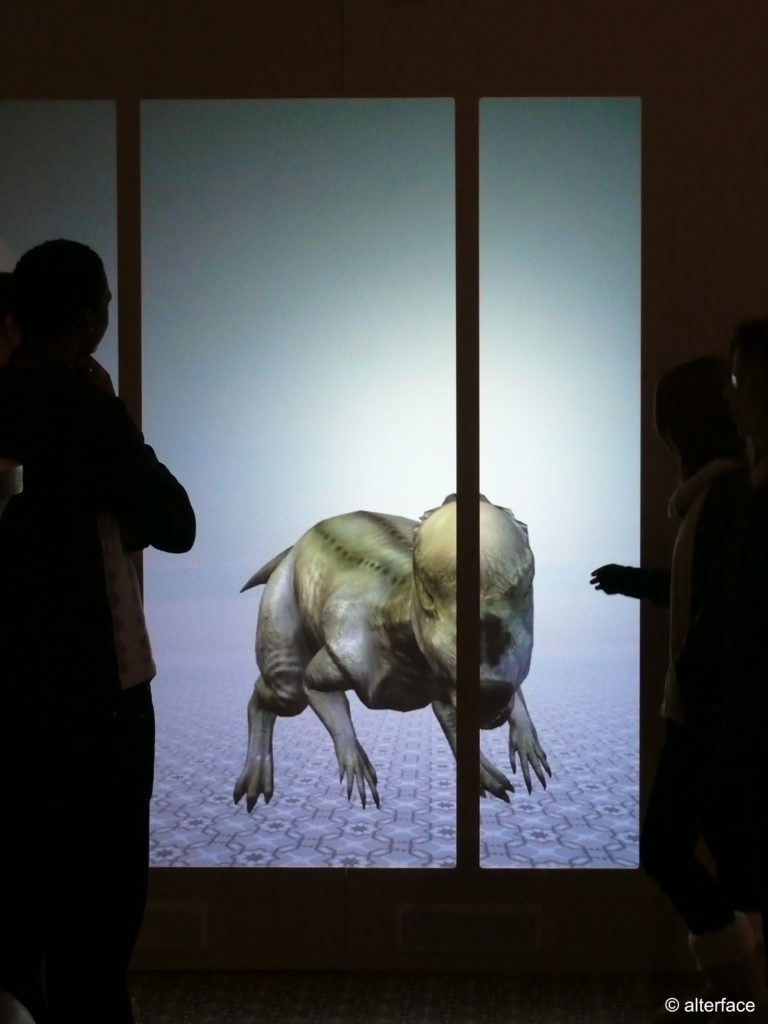
In these first projects of Alterface, only one or two people could interact with the game simultaneously. This changed when the company was hired to develop their first theme park attraction in 2005: Terre en Colère (Angry Earth) in Vulcania. The park in France is a mixture between a theme park and museum, based on geology. Terre en Colère is an interactive simulator that will let 30 riders go through the experience of earthquakes, lava flows, tornados or avalanches. “We’ve made this big platform in front of a screen that was already kind of an interactive theatre. The people could use a button to choose an action and that would happen on the screen,” says Laurence. The attraction was a success and is still operating in the park today.
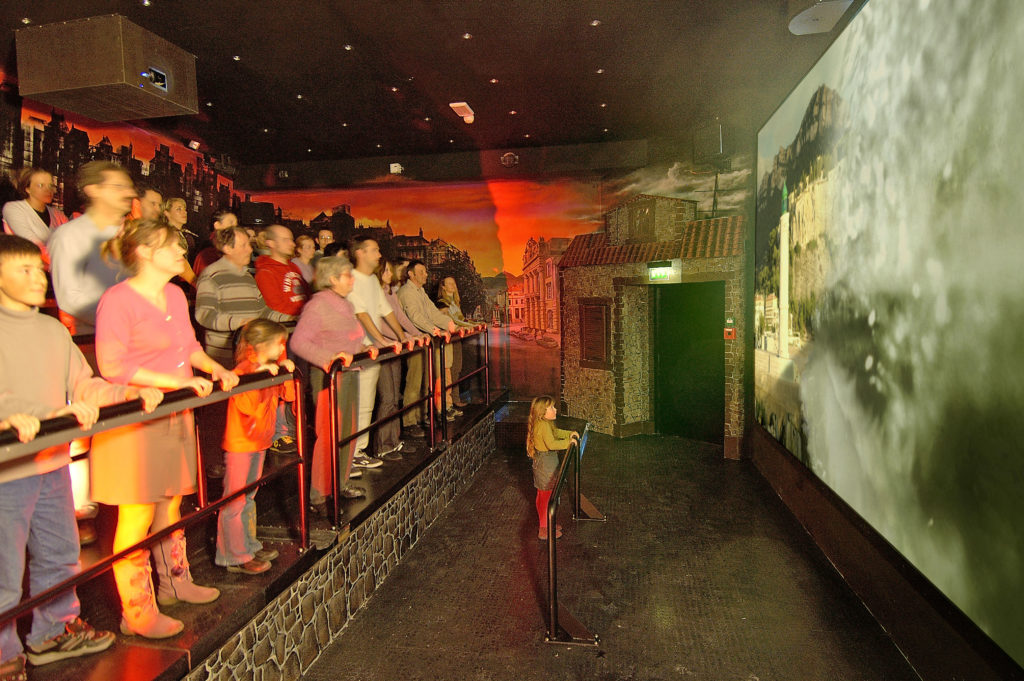
After the success of their first theme park ride, Alterface was asked to design a bigger ride, one that involved a time machine: the Future Dome. Custom designed for Dynamic Earth, Edinburgh – Scotland. “We designed an interactive dome where the people would have to choose some solution for the future. After that, the platform would rotate and bring the people into the future to see the result of their choice,” explains Laurence. Because of its custom design, only one version was ever built. But it gave Alterface the inspiration for something else. An interactive ride with its own content, that could be sold many times.
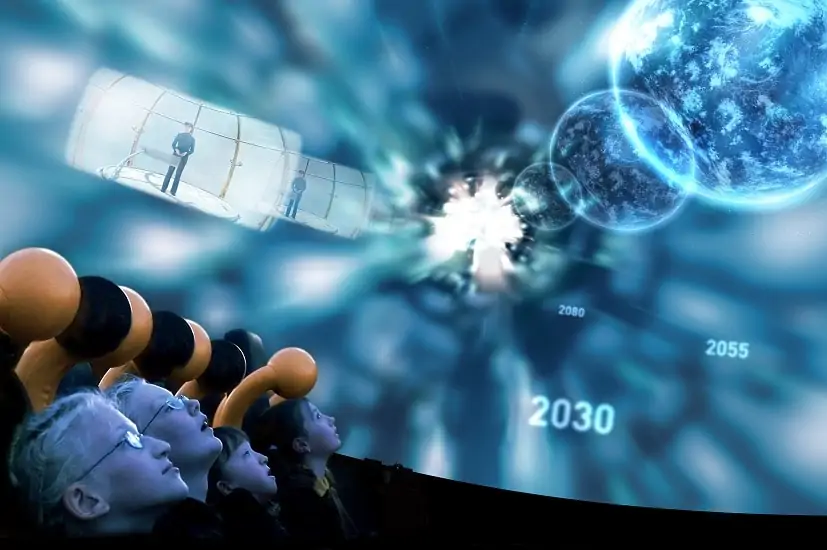
Creating the first Interactive Theatre
Bobbejaanland (Lichtaart – Belgium) is no stranger to interactive rides and is not afraid to implement new technology. The park claims that their El Paso Special dark ride is the oldest interactive dark ride in the world (and as far as we know, they are correct). Bobbejaanland was very interested in adding a new interactive experience to their park. “Bobbejaanland is all about a western theme. This time, instead of standing on a platform, we put the people on seats and decided to make a game about cowboys. That’s how it all got started,” tells Laurence. Desperados was born!
For this project, Alterface created the concept of the Interactive Theatre as we know it. An interactive theatre is a special kind of cinema that does not play a regular (short) film, but a game. Visitors will all have their own weapon, which they can use to shoot at various targets during the game. To add another dimension to the game, riders will be seated on seats that can move during the game. A show control system will keep track of the scores of each individual rider and display them at the end of the game.
There is a lot going on in an interactive theatre. The developing team really did their best to come up with many features in the ride. “It was a very creative team and we were very free. It was different from the museums where we had to respect a lot of specifications. This time we could do whatever we wanted,” recalls Laurence.
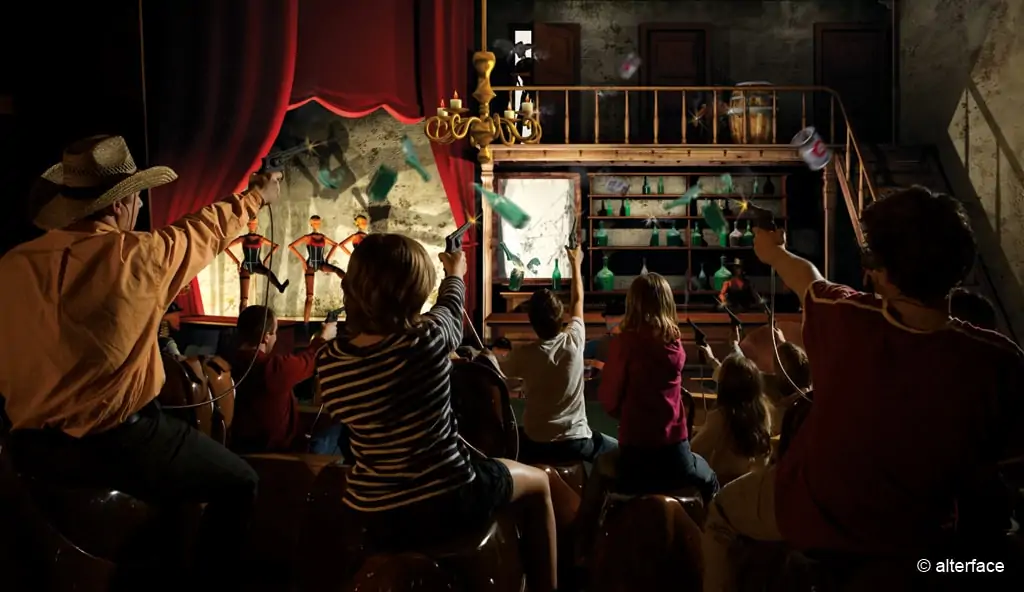
It all starts with the riders taking a seat on the ride. The Desperados interactive theatre contains moving seats that create a back-and-forth movement. “We wanted to make seats like a rodeo,” tells Laurence. But there’s much more going on besides moving seats. Your picture is taken during the ride and will be displayed two times. Once, after an introduction where you can shoot at some practice targets. The scores of this practice are displayed and players with a low score are encouraged to try harder. The second time is at the end of the game when the winner is announced and the final scores are shown to the riders. Laurence looks back at a wonderful time during the development of Desperados: “It was like magic. Everyone was enthusiastic and everyone had ideas that were really fitting the content.” It resulted in an action-packed family adventure ride.
Another potential client showed interest during the development of the ride. Fraispertuis City (Jeanménil – France), which coincidentally also has a generic western theme throughout the park, bought the second installation of the interactive theatre. “We were producing both rides at the same time. Bobbejaanland had the first opening and Fraispertuis City a few months later,” explains Laurence. Both installations opened in 2006. The version in Bobbejaanland closed in 2012, while the version in Fraispertuis City is still operating.

Ride Content: Developing the Media
In the early days of the company, Alterface produced its own media. This was also the case for the media of Desperados. With this western theme in mind, Alterface started to come up with new ideas on the style of the media content. “We were looking for something that was funny and without blood. One of our artists started to draw characters based on a wooden puppet and we thought that was very good,” explains Laurence. This wooden puppet is commonly used in art classes. This design was perfect as visitors will not be expecting (nor getting) any graphic violence from dolls and it also explains why the characters do not bleed when getting hit. Instead, the characters will drop backwards when they’re hit.
“For the story we worked with a student from a film school. We started to write a story and he really helped to keep it short and efficient,” tells Laurence. But creating media takes more than just a character-design and story. Alterface had to bring these characters to life. “I used to work with a studio in Brussels. This studio was working with a lot of actors and voices and we found someone who could really act very well and together we started to create this character of the sheriff,” tells Laurence.
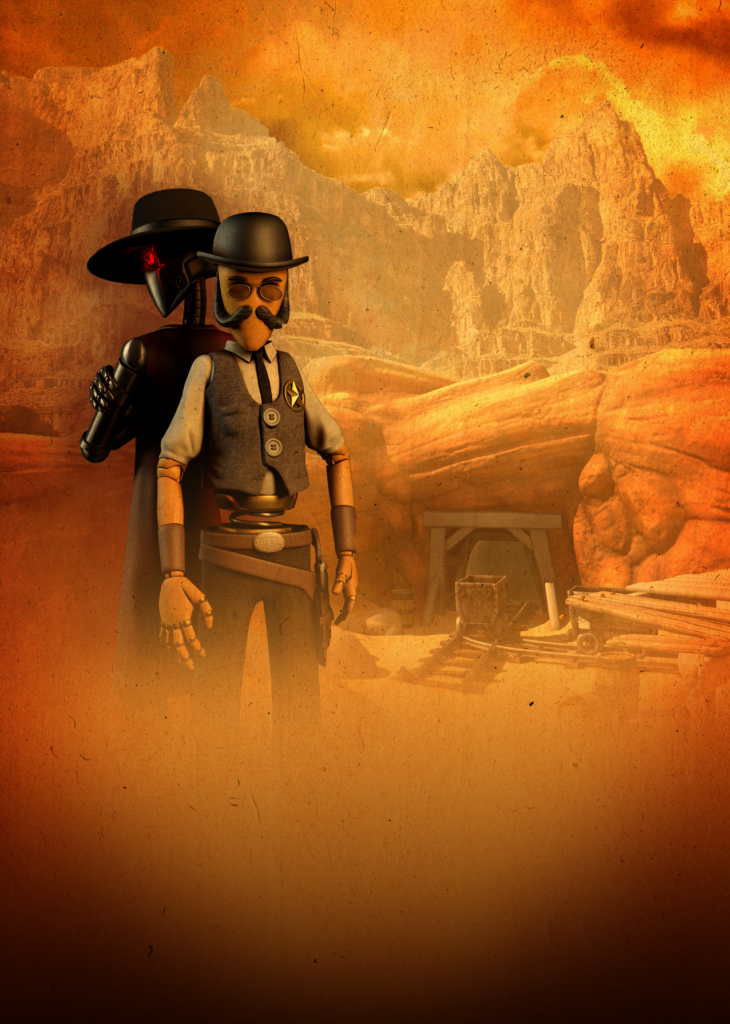
Alterface has created two variations of the Desperados multimedia content, but the global structure of each version is the same: three interactive scenes with feedback and ride parts in between. The story is as follows: The Sheriff of Desperados City will make you his deputy in pursuit of a group of Bandits. The game starts on the streets of the city where the deputies can shoot bandits on the streets, rooftops and hiding places behind objects like barrels and horsecars. Even though the seats will move, the camera angle stays the same. The second scene is usually much more dynamic and contains a pursuit of the bandits through the desert. The ride will end with a final shootout at the hideout of the bandits, which happened to be a saloon in one of the versions. The deputies can score points by shooting the bandits or the bonus targets that are hidden in the game.
The first two desperado installations were a huge success for Alterface. The company was able to sell the ride to many theme parks worldwide. “I was quite surprised that this content was also working in Japan, China and other countries. It was nice to translate the content to all these languages,” adds Laurence. The Desperados version paved the way for new versions in different themes. For the second version that Alterface designed, they decided to go for a different theme: Pirates. “It’s one of the main themes in theme parks that you can find anywhere,” explains Benjamin, meaning that a certain theme appeals to many theme parks and a large audience. In Pirate’s Plunder, the riders are attacked by skeleton pirates and will have to defend themselves by shooting the skeletons.
Instead of the Sheriff in Desperados, who is an animated character, they decided to add an actor to Pirate’s Plunder. “We had to work with a real actor for the main character. Desperados was all CGI, but for Pirate’s Plunder we had to work with a camera, script and green screen. It was a new way for us,” recalls Laurence. The experience itself uses the same kind of mechanics and is very closely related to the Desperados version. Pirate’s Plunder has not been sold as many times as the Desperados version, but was a success nonetheless.

Alterface ended up selling 68 installations of the interactive theater, in various themes, worldwide as of 2021. They do not produce all of the animations in house any longer, but they work together with animation production companies. “Alterface is a company that wants to stay small. It’s part of the spirit of the company to be very flexible, very open and reactive and then to collaborate with partners for the content for the parks,” explains Laurence. If Alterface would still be producing the media content, they would have to have a lot more employees to still be able to produce the number of rides that they produce now. Much of Alterface’s media is produced by Bon Art Studio from Bulgaria, but in some cases, they are produced by a different company. When it comes to producing media, Alterface likes to work with local studios that understand the cultural aspect of the country, but sometimes a change of studio can be related to a certain IP for the ride.
Custom Content
Even though the first interactive theatre was actually created especially for Bobbejaanland, both Desperados and Pirate’s Plunder can now be considered as ‘off the shelf’-rides of which many installations can be found in parks over the world. But Alterface has also created interactive theatres with custom content. Two of these really stand out: Kinétorium at Jardin d’Acclimatation (Paris – France) and Plants vs. Zombies Garden Warfare: 3Z Arena at Carowinds (Charlotte, NC – U.S.A.).
Halfway through the 2010s, Jardin d’Acclimatation announced that they would give the complete park an upgrade. Designer Thierry Retif was hired to redesign the park. Under his leadership, the park added several rides, including an interactive theatre by Alterface. So this time, Alterface had to work with an external designer from its client: “Retif came up with the broad concept. He did some drawings and kept close to the production of the ride for the whole period. But we were quite free to propose some input. He was not really familiar with interactivity so we did that part for the project,” tells Benjamin.
The concept that Thierry Retif came up with involved a greenhouse. The invention of a mad scientist got out of hand and now mutant plants are invading Paris. Players have to use energy weapons to exterminate the plants. “Retif had a good idea of the atmosphere he wanted,” tells Laurence, “He had a mood board with a specific atmosphere. He was really open on the interactivity part and the game design. He was specific on the color of seats and that kind of detail, but he let us give our own ideas on the interactivity.”

“There’s always a slow process of three to four months of production where we propose some designs of the characters, some drafts of the story and we go step by step to get everything approved.” Alterface would be in charge of the ride and character design, while Retif would oversee each step. The team worked together with Jora Vision for the theming of the building and they would also propose their designs in this process. After the character design was created, Bon Art Studio created the media for the ride.
Usually, guests of an interactive theatre are competing individually for the best score. This is not the case in Plants vs. Zombies Garden Warfare: 3Z Arena at Carowinds. In the original Plants vs. Zombies game, two teams are competing with each other. “We wanted to reflect that on the ride,” tells Benjamin. Riders take place as two teams in two theatres side by side. Both teams will have to shoot on their own screen to score points and try to beat the other team.
But it’s not all about the points: “We realized that there was not a lot of interaction between the two teams, despite the score bar being in favor of one of the teams. We want to remind people that the other team still exists and to do so, we added some trap elements,” adds Benjamin. These traps, such as elements that occupy the opponents’ screen, make it harder for the other team. It creates another nice element that makes the interactive theatre more exciting. “It’s just some stuff so you can annoy the players of the other team for a while,” concludes Benjamin.
Alterface worked together with PopCap Games and Electronic Arts (EA) for the development of Plants vs. Zombies Garden Warfare: 3Z Arena. These game developers produced and distributed the Plants vs. Zombies games. The media was produced by Pure Imagination, a production company that has worked with existing IP more often.

Show Control
Just like any ride, an interactive theatre cannot operate without a control system. Alterface created their own control system for the interactive theatre: “Salto!” Salto! is a computer system that can control many things. “It’s something that allows us to handle the show control, the game, the photo it takes of guests, the motion of the seats, some light elements in the show. We can control it all,” explains Benjamin. Part of Salto! is the game engine. The game itself consists of pre-rendered pictures for the ride’s film, that contains bound boxes for the targets. Salto! will put all of the content together and keep track of the player’s scores to create the complete experience.
But the Salto!-system actually has another convenient feature. It uses the same technology for both on and offscreen targets and they can be used simultaneously. “We actually tried this in Bobbejaanland. We thought it would be funny to put a piano to the right of the screen and at some point, you could shoot the piano and have it play a song. But the people were so focused on the screen that they never used the piano. It was a bit of a waste of time, but we tried,” says Laurence laughing. The piano was removed again in later seasons.
But the fact is that it wasn’t really a waste of time. It was a great test run for another version of the interactive theatre: Castle of Chaos. This elaborate interactive theatre was built three times: Twice for the Hollywood Wax Museum (in Branson, Missouri and Pigeon Forge, Tennessee – U.S.A.) and once (as Nightmare) for Tusenfryd (Vinterbro – Norway). The seats of these rides are placed on a rotating platform, passing by scenes with both on and off-screen targets. “The players had to shoot at the screen, but also on statues, a zombie that was falling from the ceiling, doors that were opening. We could really play with a lot of effects. It was kind of a revolution for the interactive theatre,” tells Laurence. Unfortunately, the two installations in the United States have since closed.
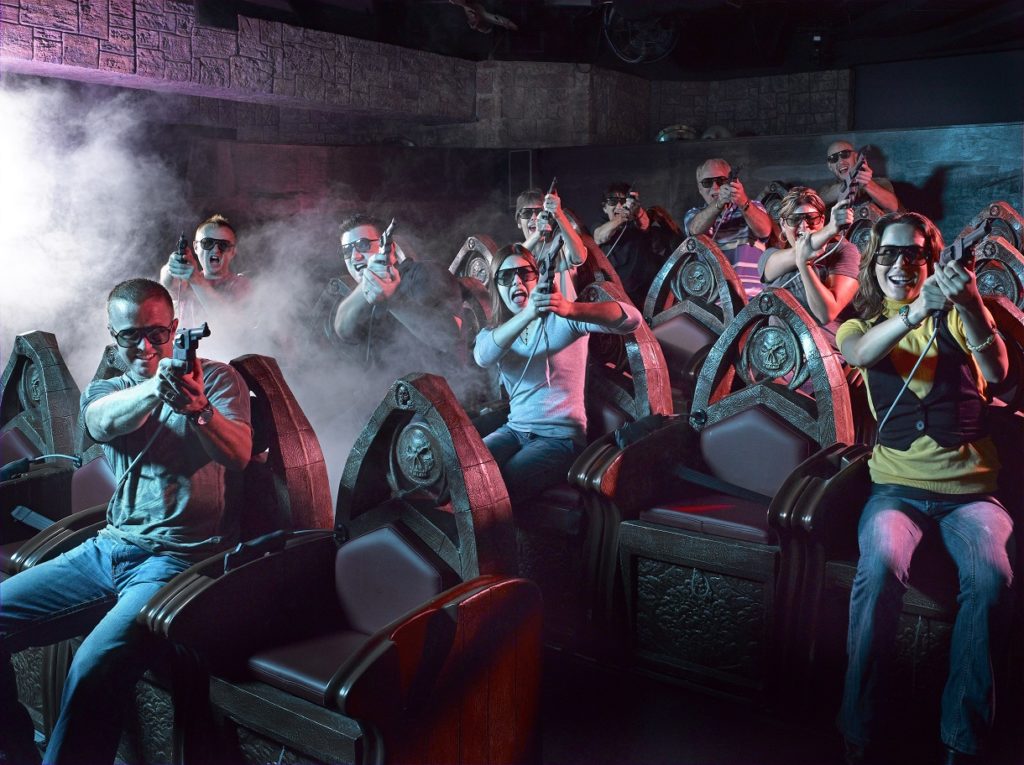
Alterface does not use the Salto!-system just for the interactive theatre. In fact, they can use it for any ride, including their interactive dark rides. Some of these rides, such as the Justice League rides for Warner Bros. Movie World and Six Flags, use this same kind of blend of both physical and digital targets. The Salto!-system is the reason why Sally Dark Rides chose to work with Alterface for these rides and Rich Hill of Sally Dark Rides praised the system in our previous special about the Justice League rides. After 15 years, the Salto!-system still functions very well and, even though it does get small updates, is still able to keep up with modern developments.
Riding Forward
While Alterface’s first theme park attraction was sort of an interactive theatre for Vulcania, the company is now best known for their work on award-winning dark rides such as Justice League: Battle for Metropolis, Bazyliszek and Popcorn Revenge. Interactivity is still the core of Alterface’s work in these rides. The biggest difference between a dark ride and interactive theatre is of course the fact that riders of a dark ride are moving from scene to scene through a building. This gives the dark ride an advantage: “The construction of the story is very different. We can relate more to the scenery. We can use the immersive décor of the dark ride and integrate that on the screen. You can’t do that with an interactive theatre,” tells Laurence.
But that does not mean that the experience of a dark ride is always better. “It also really depends on the type of gameplay that you want in your ride. There are rides that are all about shooting galleries with big screens and you don’t really care that much about the story,” explains Benjamin, “It’s all about game mechanics and secret things to shoot.” Maus au Chocolat (Phantasialand, Brühl – Germany) would be a good example. The ride experience is much more related to that of an interactive theatre. “What we have done with Bazyliszek [Legendia Śląskie Wesołe Miasteczko, Chorzów – Poland], for example, is a lot more story driven. It’s still a shooter, but there is much more background. Depending on the story you want to tell, you’ll need to add more theming, background story in the queue line and things like that,” he concludes.
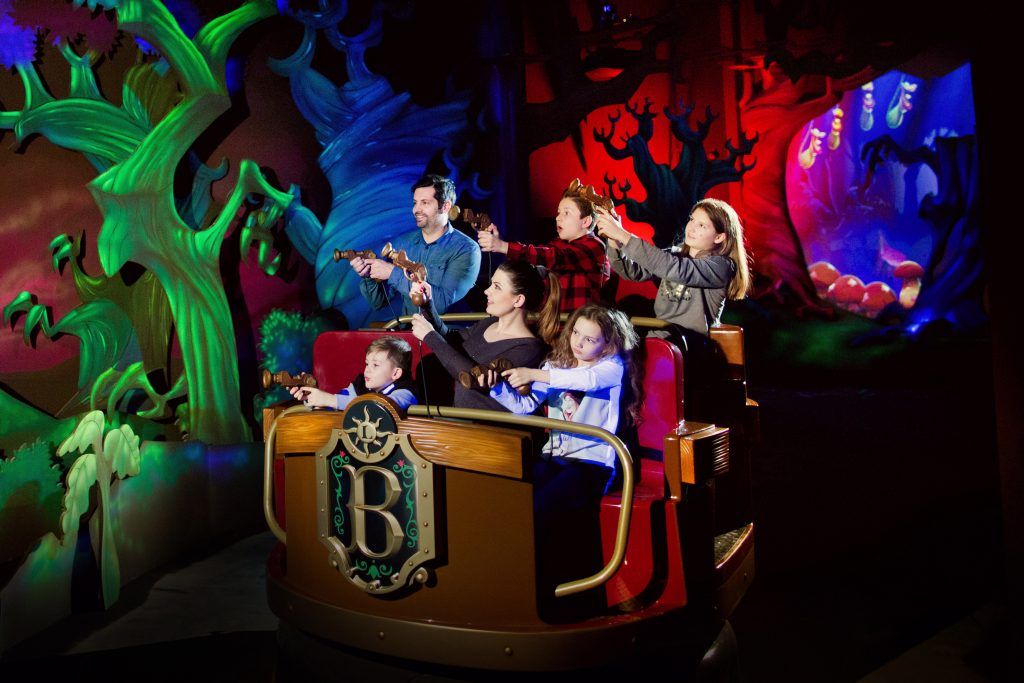
Whether it is a dark ride or interactive theatre, the products of Alterface are always a great experience for the visitors. Even though nowadays we see less new interactive theatres being opened, we are still curious to see what Alterface brings us in the future. We know that an innovative company like Alterface will not stop inventing new ways of interactivity and we would love to see those in the future. We would like to thank Laurence Beckers and Benjamin Walravens for their time and great stories about the Interactive Theatre. We would also like to thank Pim Dams and Giulia Florian of Alterface for setting up this interview.
© 2021 Dark Ride Database
Interview by Erik, Luc and Alan
Article by Erik
Images provided by Alterface



